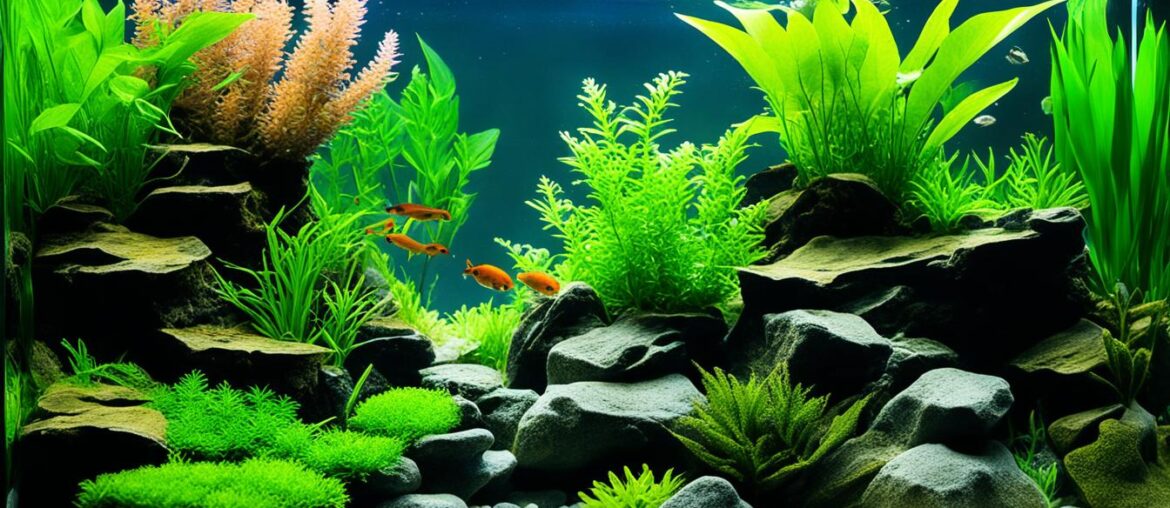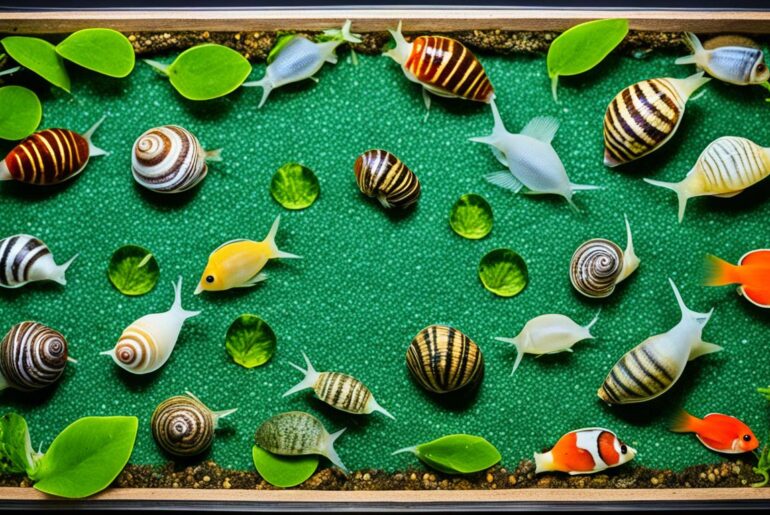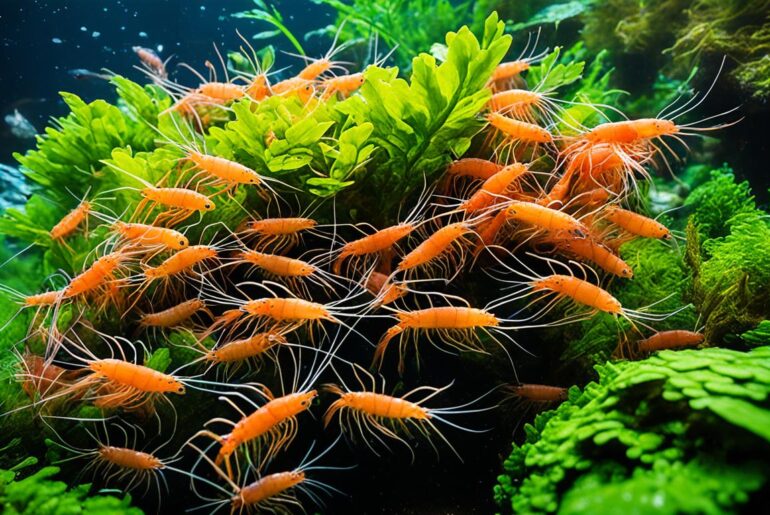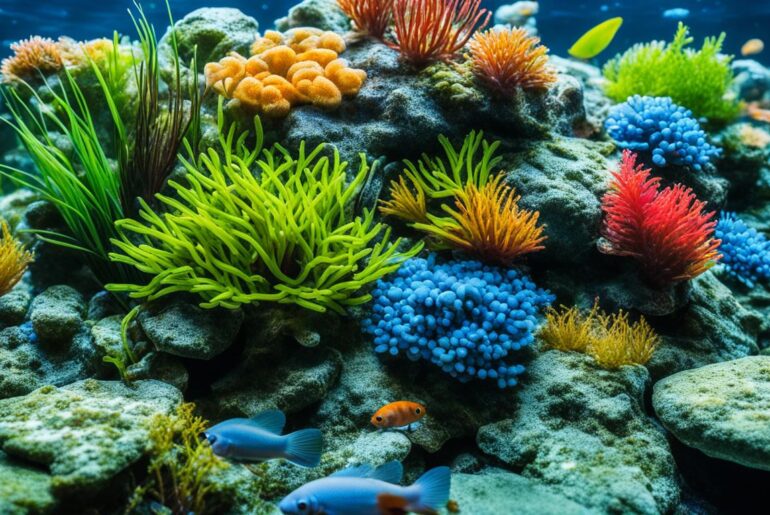Are you ready to dive into the fascinating world of freshwater invertebrates? Setting up your first freshwater invertebrate tank is an exciting venture that requires careful planning and preparation. From selecting the right equipment to creating a suitable habitat, there are essential steps to follow for a successful aquarium setup. But here’s a question to ponder: What are the key elements to consider when creating an ideal environment for your freshwater invertebrates that will ensure their health and well-being?
Setting up a freshwater invertebrate tank can be an enjoyable and rewarding experience. Whether you’re a seasoned aquarium enthusiast or just starting your aquatic journey, this guide will provide you with the necessary knowledge and tips to create a thriving habitat for your freshwater invertebrates. Let’s explore the three essential steps to get you started on your exciting aquarium adventure!
Key Takeaways:
- Setting up a freshwater invertebrate tank requires careful planning and preparation.
- The three essential steps include setting up the aquarium and stand, adding gravel and water, and installing the necessary filtration and heating systems.
- Choosing the right size aquarium, selecting compatible fish species, and proper tank maintenance are crucial for the health and well-being of your freshwater invertebrates.
- Having a freshwater aquarium provides numerous benefits, including enhancing the aesthetic appeal of your home and promoting a sense of calmness and stress reduction.
- Investing in high-quality equipment and monitoring water parameters regularly are key to maintaining optimal water quality in your freshwater invertebrate tank.
Step One: Set up aquarium and stand
Setting up a freshwater invertebrate tank begins with properly setting up the aquarium and stand. This crucial step ensures the stability and longevity of your tank, providing a suitable environment for your aquatic pets. Here’s what you need to do:
Choose the perfect location
When selecting a location for your aquarium, consider a few key factors. Avoid placing the tank in direct sunlight to prevent excessive heat and algae growth. Ensure the tank is near an electrical outlet for easy access to power. Additionally, keep it away from areas with frequent temperature fluctuations, such as drafts or heating vents.
Sturdy support for your tank
It’s essential to place your tank on a level and sturdy surface or use a dedicated aquarium stand. This ensures proper support and stability for the tank and prevents any accidents or damage. Ensure the stand or surface is capable of bearing the weight of a fully filled aquarium, as well as any additional equipment, such as filters and heaters.
“Place your aquarium out of direct sunlight, allowing at least 5″ clearance for the filter.”
“Choose a fish tank, Get an aquarium stand, Decide where to put the aquarium and stand.”
By following these steps, you’ll establish a solid foundation for your freshwater invertebrate tank, setting the stage for a successful and enjoyable aquarium setup.
Now let’s move on to the next step: adding gravel and water to your aquarium.
Step Two: Add gravel and water
Now that the aquarium is properly set up, it’s time to add the essential elements that will create a beautiful and thriving habitat for your freshwater invertebrates.
Selecting the Right Aquarium Substrate
Choosing the appropriate aquarium substrate is crucial for the health and well-being of your aquatic pets. Options like gravel or sand provide a natural and aesthetically pleasing environment for your freshwater invertebrates. Rinse the substrate thoroughly to remove any dust or debris, ensuring a clean and safe foundation for your tank.
“Use a plate when adding water to prevent gravel displacement. Rinse the gravel in clean water and add it to the aquarium, sloping it up towards the back.”
Creating a Sloped Substrate
When adding the substrate to the tank, create a sloped effect by gradually increasing the height towards the back. This not only enhances the visual appeal of your aquarium but also provides different levels for your freshwater invertebrates to explore and inhabit.
Adding Water and Ensuring its Safety
Next, it’s time to introduce water to your tank. Place a clean plate on top of the substrate to prevent the water’s force from disturbing the carefully arranged gravel. Slowly and gently pour the water onto the plate, allowing it to flow smoothly into the tank.
“If your tap water contains chlorine, add a Chlorine Neutralizer to make it safe for your aquatic life.”
It’s important to note that tap water often contains chlorine, which can be harmful to your freshwater invertebrates. To make the water safe for your aquatic pets, use a Chlorine Neutralizer to remove any traces of chlorine and make the water suitable for their well-being.
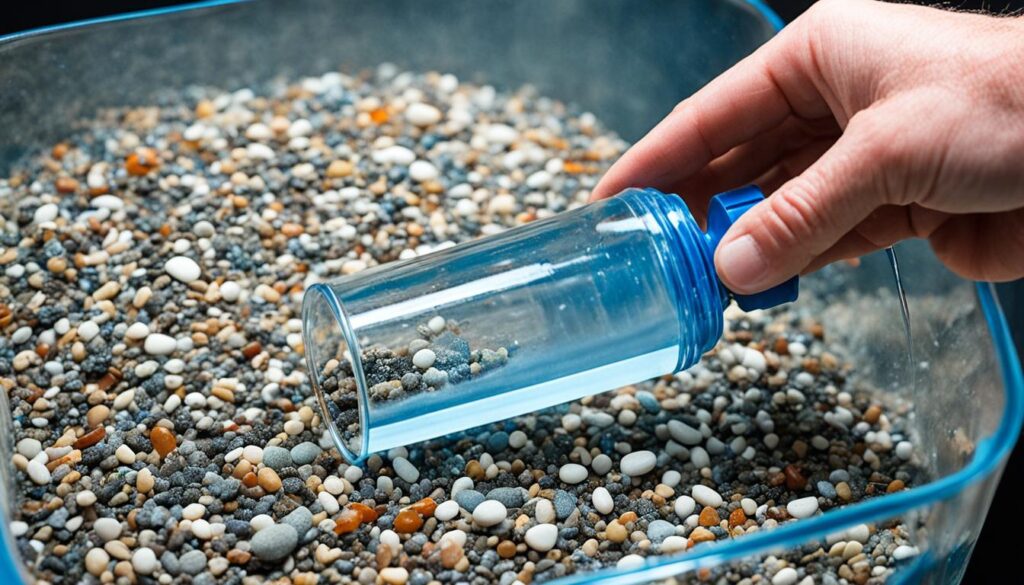
With the substrate and water added, your tank is now ready for the next step: installing the necessary equipment to maintain water quality and temperature.
Step Three: Install filter and heater
Now that the aquarium is set up and the substrate and water have been added, it’s time to focus on maintaining water quality and temperature. This step involves installing the necessary equipment – a filtration system and a heater – to create a healthy and comfortable environment for your freshwater invertebrates.
Filtration System: A reliable filtration system is essential for keeping the water clean and clear of debris and harmful substances. There are different types of aquarium filtration systems available, such as hang-on-back filters and under-gravel filters. Choose one that suits your preferences and the size of your tank. Position the filter according to the manufacturer’s instructions to ensure proper water circulation and filtration.
Heater: Maintaining a stable water temperature is crucial for the well-being of your freshwater invertebrates. Install a heater in your tank to regulate the temperature within the desired range. It is recommended to place the heater under the water level and near the input to the filter for optimal heat distribution.
| Filtration System | Heater |
|---|---|
| Choose a suitable filtration system based on tank size | Position the heater under the water level |
| Follow manufacturer’s instructions for installation | Place the heater near the input to the filter |
| Ensure proper water circulation and filtration | Set the desired temperature for your freshwater invertebrates |
By installing a filtration system and heater, you are taking the necessary steps to maintain water quality and temperature control in your freshwater invertebrate tank. These components will contribute to the overall health and comfort of your aquatic pets, creating an environment where they can thrive.
Step Four: Decorate
Now it’s time to add aesthetic elements to the aquarium. Adding decorations and live plants will not only enhance the visual appeal of your aquarium but also provide a more natural and stimulating environment for your freshwater invertebrates.
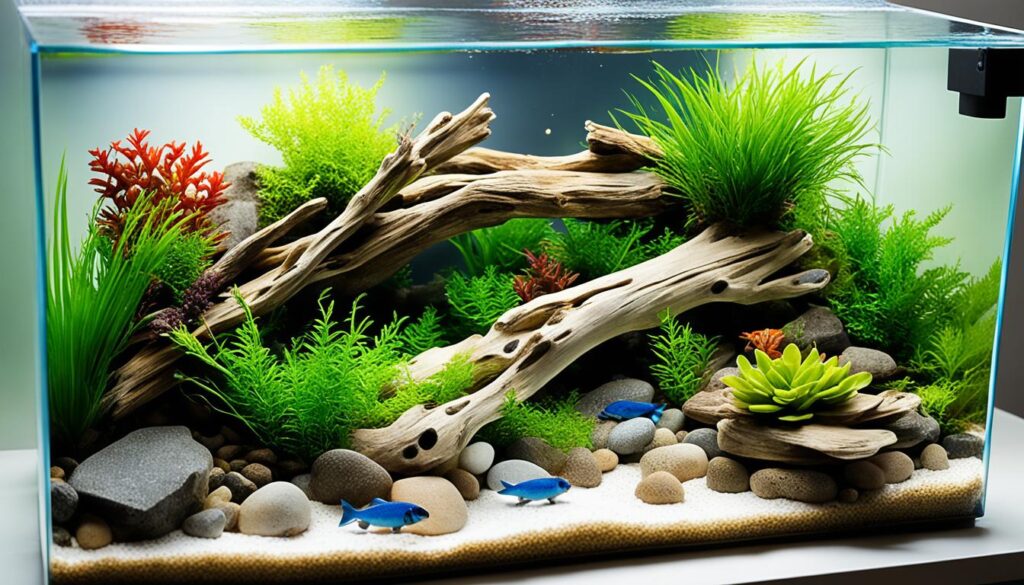
Add Decorations
Choose decorations that suit your personal style and the needs of your freshwater invertebrates. Driftwood and rocks are popular options that not only provide hiding places but also create natural-looking habitats. However, it’s important to ensure that there is plenty of open swimming space for your aquatic pets. Place the decorations strategically, allowing for easy access and movement within the tank.
Introduce Live Plants
Live plants not only add beauty to your aquarium but also serve practical purposes. They oxygenate the water, provide shelter, and help maintain water quality. Before adding live plants to your tank, rinse them with clean water to remove any dirt or unwanted substances.
When arranging the plants, consider the different layers in the aquarium: background, accent, and foreground. Background plants, such as Java Fern or Amazon Sword, are taller and placed against the back of the tank. Accent plants like Anubias or Java Moss can be arranged in the middle, while foreground plants like Cryptocoryne or Dwarf Hairgrass are placed in the front, near the glass. Additionally, you can add a few special stones for added interest.
Complete the Setup
Once you have added the decorations and live plants, fill the tank with water. Turn on the filter and heater to ensure that the conditions are suitable for your freshwater invertebrates. It’s important to allow the tank to stabilize for at least 24 hours before adding any fish. This period allows the water parameters to settle and ensures a safe and healthy environment for your aquatic pets.
I hope you enjoy creating a captivating underwater world with your aquarium decorations and live plants!
Step Five: Add Fish!
Now comes the exciting part—introducing fish to your freshwater invertebrate tank. This step is crucial for establishing a balanced ecosystem and bringing life to your aquarium. Follow these recommendations to ensure a successful fish introduction:
- Start with a small number of fish, totaling around 10 inches in length. This allows the nitrogen cycle to establish and promotes a healthy tank environment.
- Before releasing the fish into the tank, it’s essential to acclimate them properly. This process helps them adjust to the new water conditions and reduces the risk of shock. To acclimate the fish:
1. Float the closed fish bag in the tank for about 15 minutes to allow temperature equalization.
2. Gradually add small amounts of tank water to the bag every 5 minutes over the course of 30 minutes.
3. After 30 minutes, gently net the fish from the bag and release them into the tank.
During the acclimation process, keep an eye on water parameters, such as ammonia and nitrite levels. Wait for these levels to return to zero before gradually adding more fish. It’s crucial to follow stocking recommendations based on your tank size to avoid overcrowding and maintain a healthy environment for your freshwater invertebrates.
Choosing Peaceful Community Fish
When selecting fish for your freshwater invertebrate tank, opt for peaceful community species that are compatible with your invertebrates. Consider the following examples:
- Danios
- Rainbows
- Tetras
- Barbs
- Rasboras
- Angels
These fish are known for their peaceful nature and are less likely to disturb or harm your invertebrates. However, always research the specific needs and behaviors of each species to ensure compatibility and create a harmonious tank environment.
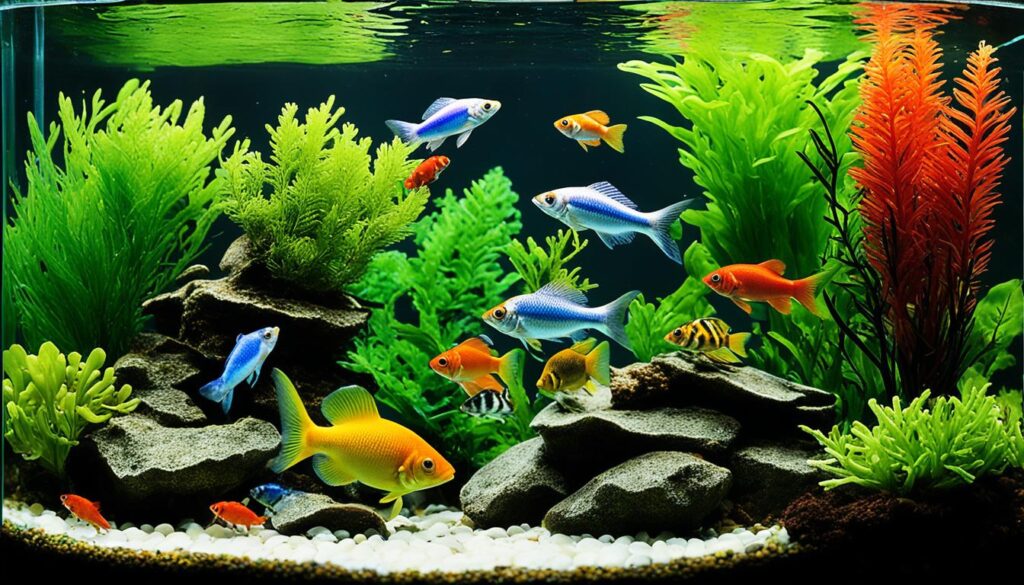
Adding fish to your freshwater invertebrate tank completes the setup process and brings a new level of vibrancy to your aquarium. Remember to follow the stocking recommendations, properly acclimate the fish, and monitor water parameters for a thriving aquatic community.
The Benefits of Having a Freshwater Aquarium
Having a freshwater aquarium in your home offers numerous benefits. It brings beauty, color, and life to your surroundings, enhancing the overall aesthetic appeal of your space. Observing and interacting with the aquatic pets can also provide a sense of calmness and help reduce stress. The tranquil environment created by the aquarium can have a positive impact on mental well-being.
“Adding an aquarium to your home is the perfect way to bring beautiful color and life to your surroundings.”
When you have an aquarium, you have a living masterpiece right in your living room. The vibrant colors of the fish, the lush greenery of live plants, and the graceful movements of the aquatic creatures create a captivating display that can instantly uplift your mood. It’s like having a piece of nature right at your fingertips.
“Observing and interacting with your aquatic pets can help lower your blood pressure and reduce the stress of everyday life.”
Watching fish swim peacefully in the water can be mesmerizing and therapeutic. It has been scientifically proven that observing fish in an aquarium can help reduce stress and anxiety. The gentle movement of the fish and the soothing sound of the water can create a sense of tranquility, allowing you to relax and unwind after a long day.
Having an aquarium can also provide a calming focal point in your home. Instead of staring at screens or being surrounded by the constant noise of technology, you can take a moment to simply observe the beauty of the underwater world. This mindful activity can help you disconnect from the outside world and find inner peace.
Furthermore, taking care of an aquarium can provide a sense of responsibility and purpose. Feeding the fish, maintaining the water quality, and creating an ideal environment for your aquatic pets can be a rewarding experience. It allows you to connect with nature and learn about the delicate balance of ecosystems.
Image:
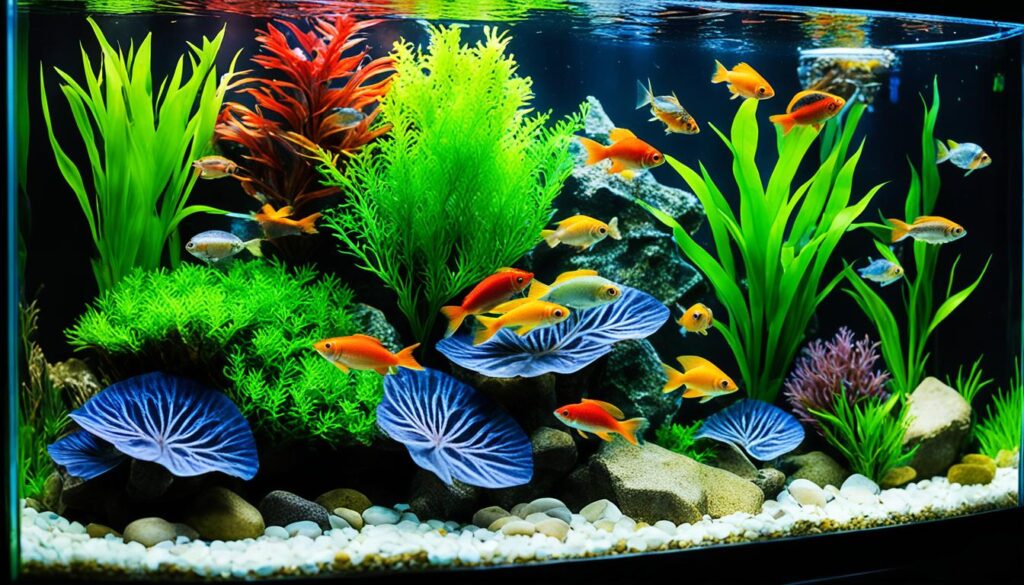
Lastly, a freshwater aquarium can be an exquisite addition to your home decor. It adds a unique touch to any space, whether it’s a living room, bedroom, or home office. You can choose from a variety of tank designs, lighting options, and decorative elements to create a visually stunning display. The aquarium becomes a conversation piece and a focal point that adds personality and charm to your home.
Key Benefits of Having a Freshwater Aquarium:
- Enhances the aesthetic appeal of your home
- Reduces stress and promotes relaxation
- Provides a calming and tranquil environment
- Fosters a sense of responsibility and purpose
- Adds a unique and captivating element to your home decor
Choosing the Right Size Aquarium
When setting up a freshwater invertebrate tank, it’s crucial to select the appropriate aquarium size that suits your needs and ensures the well-being of your aquatic pets. The choice of aquarium size depends on several factors, including the available space in your home and the type and number of fish you plan to keep.
While there is a general rule that suggests a 55-gallon aquarium can accommodate up to 55 inches of fish (adult sizes), it’s essential to research the specific needs of the fish species you intend to have. Fish compatibility is crucial to creating a harmonious and thriving aquatic environment.
Consider the behavior, size, and specific requirements of the fish species. Some fish may require larger tanks to thrive, while others may be more suitable for smaller aquariums. Researching the recommended tank size for the fish species you’re interested in will help ensure their well-being and reduce the risk of overcrowding.
Here is a helpful list of factors to consider when choosing the right size aquarium:
- The space available in your home for the aquarium
- The compatibility and specific needs of the fish species
- The swimming and territory requirements of the fish
- The potential growth size of the fish
- The filtration and maintenance capabilities of the tank
By carefully considering these factors, you can make an informed decision and create a suitable habitat for your freshwater invertebrates. Remember, a properly sized aquarium will provide ample space for your fish to swim and thrive, ensuring their health and happiness.
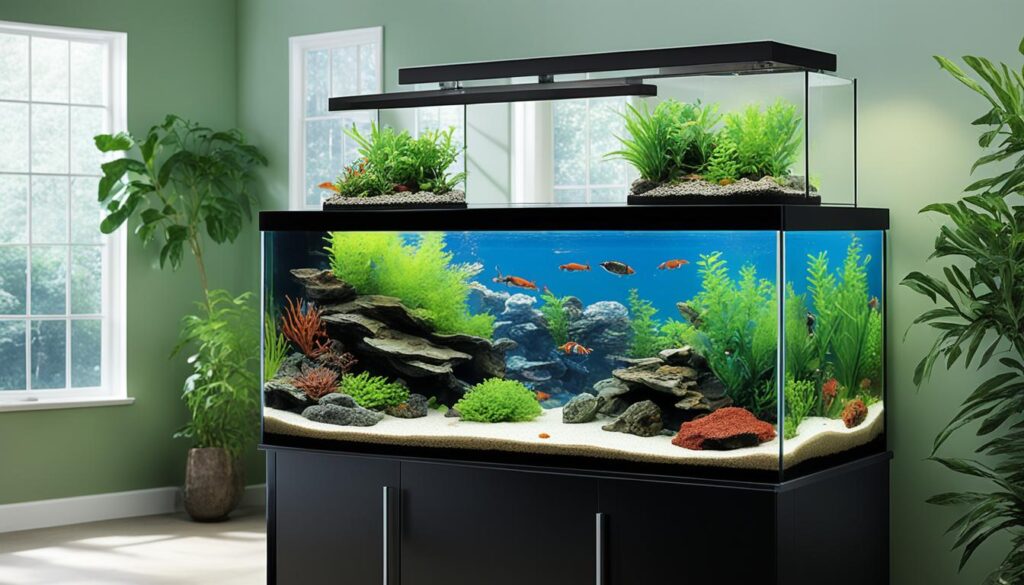
| Fish Species | Tank Size (Gallons) |
|---|---|
| Neon Tetra | 10 |
| Platy | 10 |
| Betta Fish | 5 |
| Angelfish | 30 |
| Dwarf Gourami | 10 |
| Harlequin Rasbora | 10 |
| Corydoras Catfish | 20 |
| Marbled Hatchetfish | 20 |
Remember that these are general recommendations and may vary based on the specific needs of the fish species and their compatibility with freshwater invertebrates. It’s essential to do thorough research and seek advice from experienced aquarium enthusiasts or professionals to ensure the best outcome for your freshwater invertebrate tank.
Essential Aquarium Equipment
To ensure a successful freshwater invertebrate tank setup, certain essential equipment is required. This includes a suitable heating system to maintain the desired water temperature for your fish, a reliable filtration system to keep the water clean and free from harmful substances, and a lighting system if you plan to have live plants in your aquarium. Investing in high-quality equipment will contribute to the overall health and well-being of your aquatic pets.
Heating System
A heating system is vital for maintaining the optimal water temperature in your freshwater invertebrate tank. Fish are ectothermic, meaning they rely on the environment to regulate their body temperature. Therefore, it’s crucial to choose a heater that can provide consistent warmth to create a comfortable habitat for your aquatic pets. Consider the size of your tank and the specific temperature requirements of your fish species when selecting a heater.
Filtration System
A reliable filtration system is essential for maintaining water quality in your freshwater invertebrate tank. Filtration helps remove waste, excess nutrients, and harmful substances, ensuring a clean and healthy environment for your fish. There are various types of filtration systems available, such as mechanical, biological, and chemical filters. Choose one that suits your tank size and meets the specific needs of your fish and freshwater invertebrates.
Lighting System
If you plan to have live plants in your aquarium, a lighting system is necessary for their growth and development. Live plants require a certain amount of light to undergo photosynthesis and thrive. Additionally, lighting can enhance the visual appeal of your freshwater invertebrate tank, creating a vibrant and natural-looking underwater landscape. Choose a lighting system that provides the appropriate spectrum and intensity of light for your plants and fish.
| Equipment | Description |
|---|---|
| Heating System | Maintains the desired water temperature for fish. |
| Filtration System | Cleans the water by removing waste and harmful substances. |
| Lighting System | Provides the necessary light for live plants in the aquarium. |
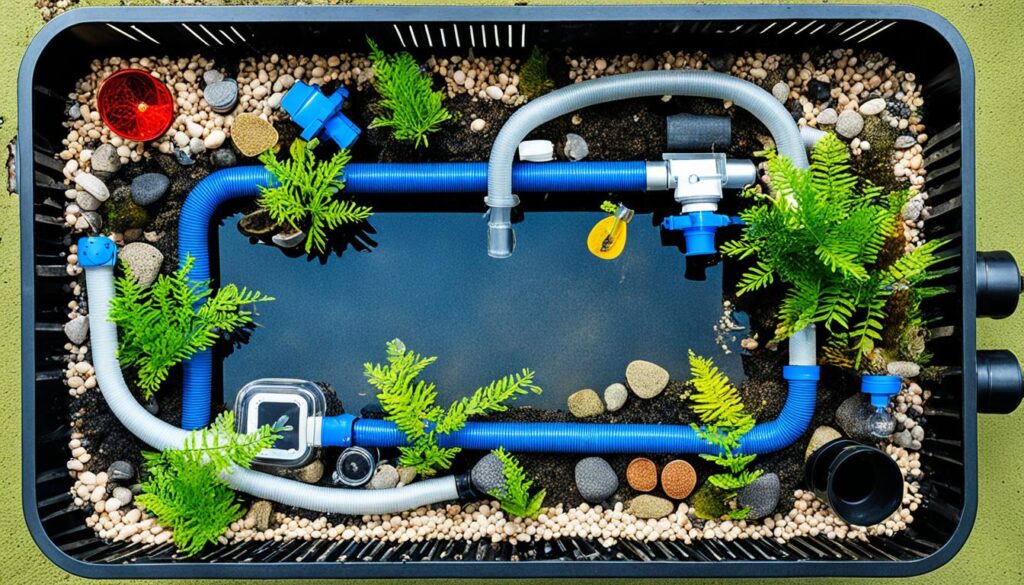
Proper Tank Maintenance
Regular tank maintenance is essential for ensuring the health and well-being of your freshwater invertebrates. By following a few simple steps, you can maintain optimal water quality and prevent the buildup of harmful substances in your aquarium.
To start, it’s important to monitor the water parameters regularly. Test for ammonia, nitrite, and nitrate levels to ensure they are within the appropriate range for your freshwater invertebrates. This will help you identify any imbalances or potential issues early on.
To maintain optimal water quality, perform regular water changes. This will help remove accumulated debris, waste, and excess nutrients from the tank. Aim to change about 10-15% of the water every week or as needed based on your water testing results.
In addition to water changes, it’s crucial to clean the tank and equipment regularly. Use a gravel vacuum to remove any debris or waste from the substrate, paying extra attention to areas where waste tends to accumulate. Scrub the inside of the tank and decorations to remove algae or other buildup. Be sure to use aquarium-safe cleaning products to avoid harming your freshwater invertebrates.
Proper filter maintenance is also essential. Regularly clean or replace filter media to ensure optimal filtration. Consult the manufacturer’s instructions for specific guidance on filter maintenance.
Remember:
If you’re starting a new aquarium, the amount of information on the internet can be overwhelming. While some instructions may seem detailed, it’s important to take them seriously to avoid common pitfalls for beginners.
Summary: Proper Tank Maintenance
In summary, regular tank maintenance, including monitoring water parameters, performing water changes, and cleaning the tank and equipment, is vital for the health and longevity of your freshwater invertebrate tank. By maintaining optimal water quality and preventing the buildup of harmful substances, you can provide a thriving habitat for your aquatic pets.
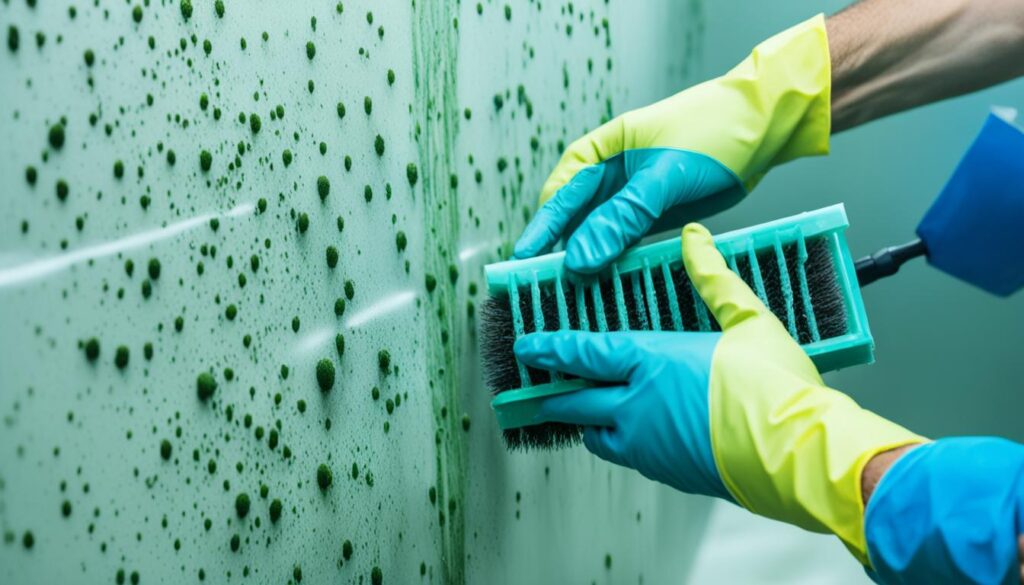
| Maintenance Steps | Frequency |
|---|---|
| Monitor water parameters | Weekly |
| Perform water changes | 10-15% weekly |
| Clean tank and equipment | As needed |
| Maintain filter | As needed, consult manufacturer instructions |
The Best Fish for a Freshwater Aquarium
When stocking your freshwater invertebrate tank, it’s important to choose fish species that are compatible with each other and with the specific requirements of your tank. Opt for peaceful community fish that get along well with freshwater invertebrates.
Popular options include:
- Bottom dwellers
- Algae eaters like Otocinclus Catfish
- Various species of danios
- Tetras
- Barbs
- Rasboras
- Angels
Research the particular needs and behaviors of each species to ensure a harmonious tank environment.
Other peaceful community fish include: Danios, Rainbows, Tetras, Barbs, Rasboras, Angels, etc.
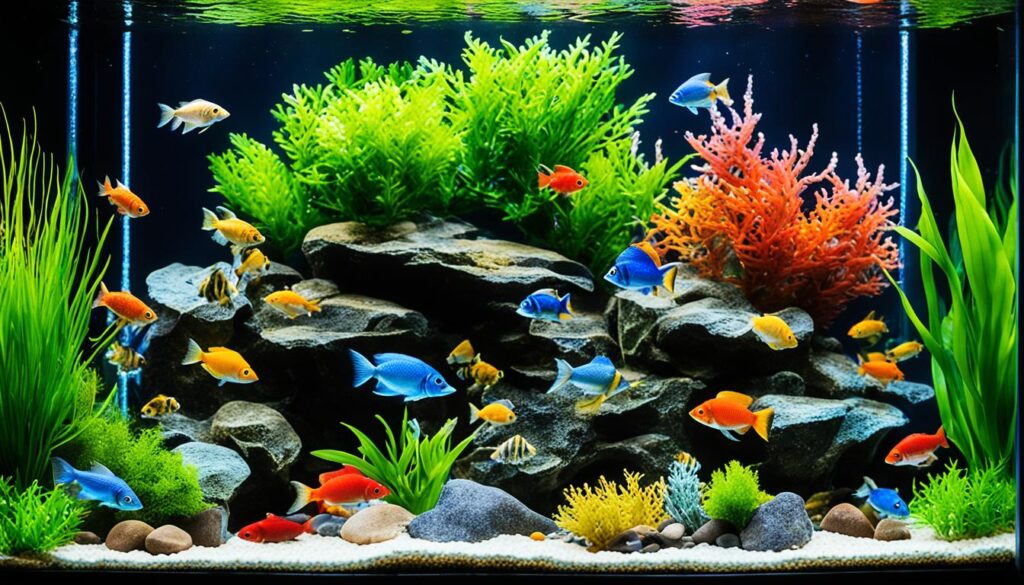
The Benefits of Peaceful Community Fish
Choosing peaceful community fish for your freshwater aquarium has several advantages. These fish typically have compatible temperaments, making them less likely to display aggression towards each other or your freshwater invertebrates. They can also help maintain a balanced ecosystem by consuming algae and scavenging for leftover food, promoting overall cleanliness in the tank. Additionally, peaceful community fish create a visually appealing display with their vibrant colors and diverse patterns, enhancing the beauty of your aquarium.
Conclusion
Setting up a freshwater invertebrate tank can be a rewarding and enjoyable experience. By following the steps outlined in this guide and considering the needs of your fish and tank, you can create a thriving aquatic habitat in your home.
Remember to choose the right equipment, properly acclimate your fish, and provide regular maintenance to ensure the health and well-being of your freshwater invertebrates. A successful aquarium setup requires attention to detail and commitment to providing a suitable environment for your aquatic pets.
Enjoy the beauty and tranquility of your new aquarium as you watch your freshwater invertebrates thrive in their carefully crafted habitat. With proper care and maintenance, your aquatic pets will bring joy and fascination to your everyday life. Happy fishkeeping!
FAQ
What are the three essential steps to setting up a freshwater invertebrate tank?
The three essential steps are setting up the aquarium and stand, adding gravel and water, and installing the filter and heater.
How do I properly set up the aquarium and stand?
Choose a suitable location for the tank, ensuring it is out of direct sunlight and near an electrical outlet. Place the tank on a level, sturdy surface or use a dedicated aquarium stand for stability and support.
What should I consider when adding gravel and water to the tank?
Select an appropriate substrate, such as gravel or sand, and rinse it thoroughly before placing it in the tank. Slope the substrate towards the back for aesthetic purposes. Use a plate when adding water to prevent displacement of the substrate and add a chlorine neutralizer if your tap water contains chlorine.
What equipment do I need to install for proper filtration and temperature control?
Install a suitable filtration system, such as a hang-on-back filter or an under-gravel filter, based on your preferences and tank size. Install a heater to maintain a stable water temperature within the desired range for your freshwater invertebrates.
How should I decorate my freshwater invertebrate tank?
Add decorations such as driftwood or rocks, ensuring there is plenty of swimming space for the freshwater invertebrates. Rinse live plants with clean water before placing them in the tank. Arrange the background, accent, and foreground plants, along with other decorations, to create an appealing underwater environment.
When is it safe to add fish to the freshwater invertebrate tank?
Start by adding a small number of fish, around 10 inches total, to establish the nitrogen cycle and ensure the tank is properly balanced. Properly acclimate the fish before releasing them into the tank. Monitor water parameters and wait for them to return to zero before gradually adding more fish.
What are the benefits of having a freshwater aquarium?
Having a freshwater aquarium can bring beauty, color, and life to your surroundings, enhance the aesthetic appeal of your space, and provide a sense of calmness and stress reduction. Observing and interacting with the aquatic pets can have a positive impact on mental well-being.
How do I choose the right size aquarium for my freshwater invertebrates?
Consider the space available in your home and select an aquarium that can accommodate the type and number of fish you plan to have. Research compatibility and the specific needs of the fish species to ensure a suitable environment.
What essential equipment do I need for a freshwater invertebrate tank?
You will need a heating system to maintain the desired water temperature, a reliable filtration system to keep the water clean and free from harmful substances, and a lighting system if you plan to have live plants in your aquarium.
How do I properly maintain my freshwater invertebrate tank?
Regularly monitor water parameters and conduct water tests. Perform regular water changes to maintain optimal water quality and remove debris or waste. Clean the tank and equipment regularly to prevent the buildup of harmful substances.
What are some recommended fish for a freshwater aquarium?
Opt for peaceful community fish that get along well with freshwater invertebrates. Popular options include bottom dwellers, algae eaters like Otocinclus Catfish, and various species of danios, tetras, barbs, rasboras, and angels. Research each species’ needs and behaviors for a harmonious tank environment.
How do I conclude the setup of my freshwater invertebrate tank?
By following the steps in this guide and considering the needs of your fish and tank, you can create a thriving aquatic habitat. Remember to choose the right equipment, properly acclimate your fish, and provide regular maintenance to ensure the health and well-being of your freshwater invertebrates.
